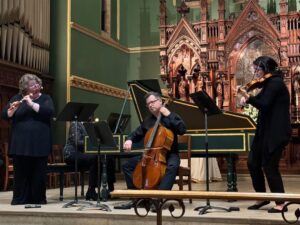Mental Health: Healing Blues.

On Sunday, January 26th, I had the opportunity to attend the Mental Health: Healing Blues and Jazz event hosted by the Tennessee-Western Kentucky Conference of the United Methodist Church at the Scarritt-Bennett Center. The Scarritt-Bennett Center was a beautiful venue to host the event with its historical and charming architecture and environment. This program aimed to bring awareness to mental health issues through music, specifically jazz and blues. Upon entering the building, they had service tables in front of the mental health event room, offering professional services to those who would like more support. The event was perfect for an afternoon of blues and jazz music. It was warm and cozy and they had food and drinks for the audience to sit back and enjoy the music.

At the event’s start, Crystal Joy was the MC of the afternoon, and she introduced all the artists, including musicians and visual artists. Henry Jones is a spoken word artist who performed with Henry Perry, a harmonica blues musician. The latter session included a performance by jazz vocalist Connye Florance and pianist Kevin Madill. Visual artist and MTSU alumnus Reverend Linda Furtado painted a thought-provoking piece with many vibrant colors throughout the musical performances as well.
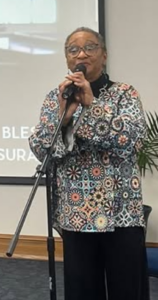
The first piece performed was titled “Do Not Lose Your Mind Today,” written and spoken by Henry Jones. Henry Perry performed on harmonica during this piece, adding to the poem’s effects. This piece was quite fun to listen to, with Jones’s deep narrative voice and the added harmonica effects from Mr. Perry. It was a beautiful story of how the mind can spiral into trouble and darkness. The twang of the harmonica creates an almost wild west aesthetic that builds on the intensity of the mind’s troubled thoughts. Perry does a fantastic job of creating tension in the story through this improvisation. It is an excellent piece to describe the current stigma on mental health issues. The negative stigma of how those with mental health issues are unable to overcome their illness. He drew upon this point in his song by acknowledging that this perception must be destigmatized because it is simply not true and that people who suffer from mental issues should not give up.
They performed another piece that featured more of the harmonica. It starts off with Henry Jones narrating the poem describing a metaphorical representation of a person acting as a child throwing a tantrum. Henry Perry then joins in and portrays this child-like tantrum with his harmonica by accelerating through quick staccato notes, denoting a rise of tension of an energetic child dancing around. He does a great job utilizing different techniques. For instance, he would vibrato and slide on the instrument, creating a quick glissando between a controlled number of notes. It was fascinating to hear this be performed live. The long vibratos that Perry communicates demonstrate this longing for peace. The ending also portrays this eventual destination of peace, to which Henry Jones stated, “I am free.” The ending encourages those with troubled souls to seek freedom through God’s gentle grace. Perry ends this piece with another harmonica moment, drawing upon the fun nature and twang of the instrument. Everyone chuckled at his funny outro of the piece.
The following piece is titled “If You Just Smile,” sung by Connye Florance with piano accompaniment by Kevin Madill. Connye beautifully glides her voice across this piece, bringing a soulful texture similar to Ella Fitzgerald. Her dream-like voice transported the audience into a comforting session that made them forget about life’s troubles. Madill’s playing also reinforced her voice, adding to this aesthetic through his superb, delicate playing. Their performance lit up the whole room, spreading many smiles across the audience. They also performed another piece titled “Now Is the Time.” Florance sings a lovely melody, encouraging those with mental health issues to choose today as the time to get help where it is needed. It was very soulful and cheerful, creating a welcoming atmosphere for those looking for healing.
After the event, I checked out some of the tabled services there. Vanderbilt’s Alzeheimer Research Center, healthcare for the elderly, and career coaches from Goodwill were all there and offered great advice and forms for anyone that needed it.
It was a comforting event, with much light and fruit and people willing to work through and help. I thoroughly enjoyed this jazz and blues session hosted by the Tennessee-Western Kentucky Conference of the United Methodist Church. It was a very exceptional performance by these professional musicians, and I hope to listen to them again.
“Overflowing and Unlimited . . .” – Nelsons and the BSO release live recording of the Turangalîla-Symphonie
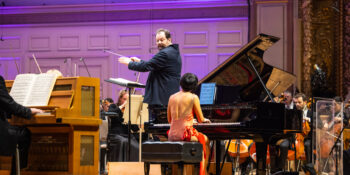
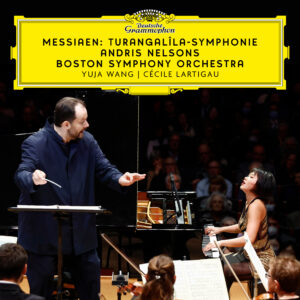 I will admit that I have a rather large soft spot for the music of Olivier Messiaen. Experiments with total serialism, Medieval and Hindustani rhythmic influences, incorporation of bird song (if somewhat freely adapted), modes of limited transposition, nods to Japanese Gagaku and Balinese gamelan, all imbued with a religious mysticism through the lens of synesthesia and a truly original approach to orchestration – what’s not to love? So, when I discovered that the Boston Symphony Orchestra and Deutsche Grammophon would be releasing a live concert recording of Messiaen’s Turangalîla-Symphonie to coincide with the 75th anniversary of the work’s word premiere, my inner music nerd was thrilled that the work was being recognized in this way.
I will admit that I have a rather large soft spot for the music of Olivier Messiaen. Experiments with total serialism, Medieval and Hindustani rhythmic influences, incorporation of bird song (if somewhat freely adapted), modes of limited transposition, nods to Japanese Gagaku and Balinese gamelan, all imbued with a religious mysticism through the lens of synesthesia and a truly original approach to orchestration – what’s not to love? So, when I discovered that the Boston Symphony Orchestra and Deutsche Grammophon would be releasing a live concert recording of Messiaen’s Turangalîla-Symphonie to coincide with the 75th anniversary of the work’s word premiere, my inner music nerd was thrilled that the work was being recognized in this way.
Messiaen never really does anything halfway, and the Turangalîla-Symphonie as a “hymn to joy” is no exception. Serge Koussevitzy and the Boston Symphony placed no limitations when commissioning the work in 1946, but one doubts that a ten movement work for large orchestra, featuring extensive percussion colors, the electronic ondes Martenot, and a virtuoso piano part was what they anticipated. Perhaps due to these features and not in spite of them, Turangalîla-Symphonie has become one of Messiaen’s most iconic works. With pianist Yuja Wang and Cécile Lartigau’s ondes Martenot, the BSO revisited this commissioned work last April and have released the live recording created from these concerts.
Andris Nelsons and the BSO hold nothing back in this often muscular interpretation. After all, Messiaen can be direct at times, and often lets his stronger structures bluntly speak for themselves. Nelsons certainly didn’t shy away from Messiaen’s extremes – allowing the dense and powerful gestures to come to the fore, at times with a surgical clarity and transparency. Though perhaps due to the limitations of dynamic nuance available on recordings, the contrast between the sweeping full ensemble statements and the intimate but lush responses was not as effective as I have experienced in live performances of the work. The statue theme, love theme, and glissandi in the ondes Martenot were often allowed to grow to their fullest expression – likely very effective in a live performance within a large concert hall where the sound has room to dissipate, but at points on the recording they could be so omnipresent that they were more reminiscent of a Tex Avery production than Messiaen’s orchestral expression of all encompassing love.
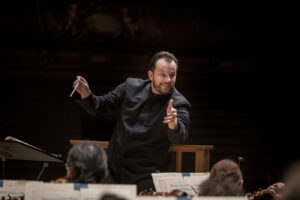
As this was a recording of a live concert performed for an audience rather than a production solely for studio microphones, some balance issues or imprecision might be expected. And though there were a few balance issues and sometimes a lack of dynamic contrast (again expected in recorded formats), the musicians of the BSO are polished and flawless in their execution. Issues with balance and dynamic range tend to work against any composition, but for a composer who communicates so effectively via coloristic contrast and textural variation, it can be difficult for the dynamic range of a recording to fully convey these exchanges with the nuance that makes this work so iconic.
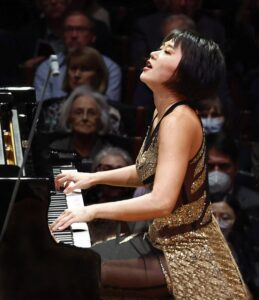
However, no lack of dynamic subtlety stood in the way of Nelsons’s willingness to embrace the extremes of Messiaen’s tutti writing – offering listeners the opportunity to lose themselves within the meticulous complexity of Turangalîla’s most robust moments. Of particular note, the frenetic energy and multiple layers of the fifth and tenth movements were delivered with impressive machine-like precision. Spurred by Nelsons’s bright tempo, the orchestra shimmered through the density of Messiaen’s climactic final movement with a spirit of excitement that must have been thrilling live and is certainly captured on the recording. Still, the timbral juxtapositions enjoyed in live performance can be a little flat in the recorded format (especially in busier textures), amounting to a kind of constant sensory overload of discrete statements rather than a complementary cascade of orchestral colors. Of course, in these larger contexts, being overwhelmed by Messiaen’s orchestration is kind of the point – but one wishes to be forcefully transported by the majesty of a cohesive if multi-faceted whole rather than dazzled piecemeal by the sum of its parts. Perhaps in these instances the limitations of the live recorded format cannot fully translate Nelsons’s interpretation.
Though the shared intimacy of live acoustic performance is difficult to duplicate, the recording is not without its sublime moments. The crystalline delicacy of the sixth movement Jardin du sommeil d’amour (Garden of love’s sleep), is an exercise in the power of understatement. Cécile Lartigau’s ondes Martenot blends perfectly with the muted string theme, providing a languid environment for the delicate interplay of flute, clarinet, piano, and percussion. Likewise, the solo piano work and delicate woodwinds preceding the statue theme at the conclusion of Chant d’amour 2, and the coloristic exchanges in the softer sections of the third movement, Turangalîla 1., were masterfully executed.
Yuja Wang’s performance throughout displays a strong understanding of the piano’s role within the context of the work – adding the important soloistic interjections when needed without overshadowing the ensemble. The solo piano part isn’t quite a concerto (even though the demands of the part may suggest otherwise), and this important color is required to both blend and stand out as a soloist. In the work’s more soloistic passages, Yuja Wang did not disappoint. Her playing is assured and agile, dancing through Messiaen’s angular material with grace and ease.
As a representation of the BSO’s live performance, the recording is a testament to an energetic interpretation with no lack of enthusiasm for Messiaen’s embrace of excess. Studio recordings such as Esa-Pekka Salonen’s 1986 release with the Philharmonia Orchestra or the initial recording by Seiji Ozawa and the Toronto Symphony released in 1968 may offer more nuanced readings of the work. Even so, the BSO’s committed and passionate offering catalogs a live performance that lives up to Messiaen’s own description of the work in the liner notes of the (definitive according to Messiaen) 1990 Myung-Whun Chung recording with the Orchestre de l’Opera Bastille as “a joy that is superhuman, overflowing, blinding, unlimited.”
Though the recording may feel heavy at times, the clarity of the musicianship is evident throughout. Nelsons’s performance is aggressive and leans into the extreme aspects of the work, as one might expect with such epic music. I’m thankful that the BSO chose to highlight and record such an important work. The live recording captures the exuberance and directness of the BSO’s performance and should inspire listeners to seek out more opportunities to engage with live performances of contemporary masterpieces.
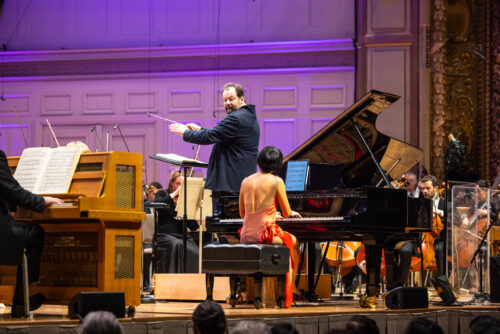
Complicidad Sonora: El Espíritu De Nashville Chamber Music Society
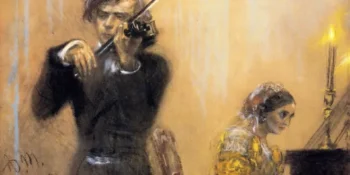
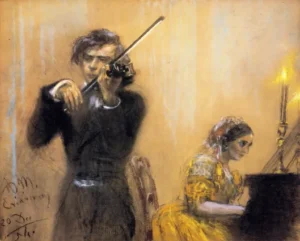
(English version here)
Romance & Heartache se tituló la velada musical que Nashville Chamber Music Society ofreció el 30 de enero en la Iglesia Metodista Calvary United. No era para menos este título; contrario a un usual programa contrastante, en esta oportunidad el público experimentó una inmersión en una época de estrechos lazos de amistad e intercambio musical. Comprendidas inicialmente como piezas vocales, las romanzas paulatinamente fueron cediendo las inflexiones de la voz y la poesía de sus versos a la subjetividad instrumental. Por lo tanto, independientemente de conocer quiénes inspiraron las piezas interpretadas en este concierto, cada compositor pudo estar dialogando también con desafíos internos.
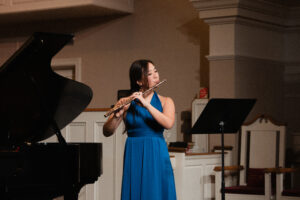
Antes de revelar los detalles íntimos de este recital, debo decir que conocer más sobre el proyecto elevó mis expectativas de disfrutar lo que para mí representa la expresión más pura del arte musical, la música de cámara. Quienes han interpretado este repertorio, reconocen que al estar tan desnuda cada melodía, la química entre los músicos y con el público son imprescindibles. Sin un director y una voz principal, conseguir una conversación fluida, recíproca y cómplice, es una de las satisfacciones más bonitas. La chelista MaryGrace Bender, fundadora y presidente de NCMS, relata que desde su época de estudio en Nashville siempre tuvo en mente este proyecto, tanto que patentó su nombre de dominio. En medio de la incertidumbre y el aislamiento de la pandemia, esta idea fue tomando forma a partir del anhelo de amigos colegas de volver a conectar. Encuentros musicales en un café llenaron de regocijo al público itinerante y el destino hizo un gesto de pulgar en alto.
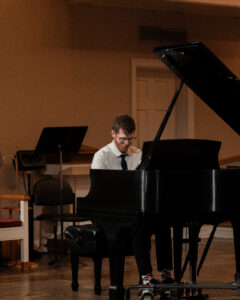
Este escenario casual se trasladó a bibliotecas, escuelas, hogares de ancianos e iglesias; músicos profesionales o aficionados pueden participar en talleres de cámara y ¡fiestas de lectura a primera vista! La misión de NCMS preserva la esencia de la camaradería musical de siglos pasados que fue también fecunda de extraordinario repertorio. Este es el caso del programa seleccionado para el concierto; las Tres Romanzas para Oboe y Piano, Op. 94 fueron un regalo de Navidad de Robert Schumann para su esposa Clara Schumann y ella dedica las Tres Romanzas para Violín y Piano, Op. 22 a Joseph Joachim, amigo íntimo de la pareja. El Trio No. 1 en Si Mayor, Op.8 de Johannes Brahms, se finalizó tan solo unos meses después de que el compositor integrara el círculo de amistad de los personajes mencionados anteriormente.
En esta ocasión, las romanzas de Schumann fueron interpretadas por Danielle Maeng y Brendan Jacklin en el arreglo para flauta y piano. Siendo la única composición que Robert escribió para oboe, un instrumento que en esa época no estaba completamente desarrollado, su complejidad técnica le ha dado el valor de pieza exigida en concursos de prestigio internacional. A pesar de los escasos lapsos para respirar en el primer y segundo movimiento, y los amplios saltos interválicos, la obra fluye con mucha naturalidad. Procurando un sonido consistente y envolvente, Maeng acariciaba el fraseo de cada melodía conectando cada uno de los motivos como si declamara una poesía. El ánimo del piano difiere un poco con esta lírica y soporta cada tema con armonías rítmicas y arpegios. En el tercer movimiento, se une a la flauta monofónicamente para luego desprenderse en forma de estela sonora.
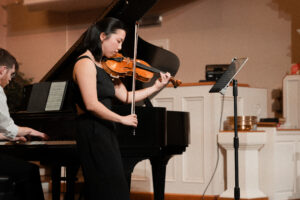
La composición de Robert estaba pensada para que Clara la interpretara, sin embargo, el rol del piano pareciera no estar afín con las aspiraciones de su esposa al compararse con el carácter contrapuntístico del Op. 22. El diálogo con el violín es intenso y apasionado; el piano no se limita a asentir y sostiene un argumento. En el entorno artístico, existe una delgada línea entre la admiración y el encantamiento. Sin caer en un sesgo novelístico, creativamente hablando Clara se dejó rendir ante el talento de Joachim. Dedicarle esta pieza contribuyó a que el desarrollo técnico de las melodías fuera versátil y en cierta manera virtuoso. Cuando el violín de Charissa Leung amplió su tamaño para reproducir las frecuencias graves de la cuerda sol, pude corroborar el estado de dicotomía que Clara debió atravesar mientras escribía esta pieza. En varias de las composiciones de los Schumann se intercambian ideas musicales que consolidan su vínculo personal. En este caso hay una alusión al motivo introductorio de la Sonata para Violín Op. 105 de Robert, pero Clara indica que debe interpretarse únicamente en la cuarta cuerda, el timbre predilecto de Joachim.
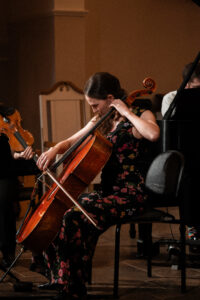
Luego de la pausa, a esta amistad de artistas románticos se une Brahms y al dueto de Leung y Jacklin se une Blender. El tema con el que inicia el primer movimiento del trio, da la sensación de ser la continuación de un diálogo previo que el espectador desconoce; no obstante, su gradual desarrollo nos va haciendo partícipes. La variedad y singularidad de los temas de cada movimiento revelan a un joven compositor que desea abarcarlo todo. Los acordes amplios y la lírica fresca del piano permitieron que obtuviéramos un primer plano de las articulaciones precisas de Brendan J., quien además supo personificar el carácter instrumentista de los tres compositores. A pesar de que en ciertas secciones Brahms pone a prueba la fluidez del ensamble con desplazamientos rítmicos y cambios abruptos de intensidad, el trio asumió magistralmente los desafíos. Sin perder la autenticidad tímbrica, Leung y Bender complementaban mutuamente sus discursos en perfecta armonía; durante los unísonos las dos intérpretes se volvieron una sola agradando a los caprichos del compositor.
El concierto logró capturar ese ambiente familiar que, a través de correspondencias y páginas de diarios, sabemos de los encuentros musicales en la casa de los Schumann. El público conoció los pensamientos y las experiencias musicales de cada intérprete como si se tratara de una reunión entre amigos. Esa es la esencia del Romanticismo: despojarse de la formalidad y atreverse a la espontaneidad.
Sonorous Kinship: The Spirit of Nashville Chamber Music Society


(versión en español aquí)
Romance & Heartache was the title of the musical evening that the Nashville Chamber Music Society presented on January 30 at Calvary United Methodist Church. The title could not have been more fitting; unlike a typically contrasting program, the audience was immersed in an era of close friendships and musical exchange this time. Initially conceived as vocal pieces, the romances gradually yielded the inflections of the voice and the poetry of their verses to instrumental subjectivity. Thus, regardless of knowing who inspired the pieces performed in this concert, each composer may have also engaged in an internal dialogue.
Before delving into the intimate details of this recital, I must say that learning more about the project heightened my expectations of experiencing what I consider the purest expression of musical art—chamber music. Those who have performed this repertoire recognize that, with each melody being so bare, the chemistry between the musicians and the audience is essential. Without a conductor or a lead voice, achieving a fluid, reciprocal, and intimate conversation is one of the most gratifying aspects. Cellist MaryGrace Bender, founder and president of NCMS, recalls that since her student days in Nashville, she had always envisioned this project—so much so that she patented its domain name. Amid the uncertainty and isolation of the pandemic, this idea began to take shape through the longing of colleagues to reconnect. Musical gatherings in a café delighted the ever-changing audience, and fate responded with a thumbs-up.

This casual setting expanded to libraries, schools, nursing homes, and churches, where professional and amateur musicians can participate in chamber workshops and even sight-reading parties! The mission of NCMS preserves the essence of musical camaraderie from past centuries, which also bore extraordinary repertoire. This is precisely the case with the selected concert program: Three Romances for Oboe and Piano, Op. 94 was a Christmas gift from Robert Schumann to his wife, Clara Schumann, who dedicated Three Romances for Violin and Piano, Op. 22 to Joseph Joachim, the couple’s close friend. Johannes Brahms’ Piano Trio No. 1 in B Major, Op. 8 was completed just a few months after the composer joined this friendship circle.

For this performance, Robert’s Romances were played by Danielle Maeng and Brendan Jacklin in the arrangement for flute and piano. As Robert’s only composition for the oboe—an instrument that at the time was not fully developed—its technical complexity has made it a required piece in prestigious international competitions. Despite the limited breathing spaces in the first and second movements and the wide intervallic leaps, the piece flows with great naturalness. Striving for a consistent and immersive sound, Maeng caressed each melodic phrase, linking the motifs as if reciting poetry. The piano’s character slightly contrasts with this lyricism, supporting each theme with rhythmic harmonies and arpeggios. In the third movement, it unites monophonically with the flute before breaking away like a sonic tail.

Robert’s composition was meant for Clara to perform, yet when compared to the contrapuntal nature of Op. 22, the piano role does not seem entirely aligned with Clara’s artistic aspirations. The dialogue with the violin is intense and passionate—the piano does not merely assent; it holds its own argument. There is a fine line between admiration and enchantment in the artistic world. Without falling into novelistic speculation, creatively speaking, Clara yielded to Joachim’s talent. Dedicating this piece to him contributed to the versatility and, in a way, virtuosity of the melodic development. When Charissa Leung’s violin expanded its size to reproduce the deep frequencies of the G string, I could sense the dichotomy Clara must have faced while composing this piece. Many of the Schumanns’ compositions exchange musical ideas that solidify their personal bond. In this case, there is an allusion to the opening motif of Robert’s Violin Sonata Op. 105, but Clara instructs that it be played exclusively on the fourth string, Joachim’s favored timbre.

After the intermission, Brahms joined this circle of Romantic artists, and Bender joined the duo of Leung and Jacklin. The opening theme of the first movement of the Trio feels like the continuation of an unknown prior dialogue—yet as it gradually unfolds, it draws the audience in. The variety and uniqueness of the themes in each movement reveal a young composer eager to embrace everything. The broad chords and fresh lyricism of the piano allowed for a close-up of Brendan J.’s precise articulations, as he masterfully embodied the instrumental character of all three composers. Despite Brahms testing the ensemble’s fluidity with rhythmic displacements and abrupt dynamic shifts, the trio masterfully embraced the challenges. Without losing the authenticity of their timbres, Charissa L. and Marygrace B. seamlessly complemented each other’s discourse in perfect harmony; during unison passages, the two performers became one, fully indulging the composer’s whims.
The concert successfully captured the familiar atmosphere we know from letters and diary pages about the musical gatherings at the Schumann household. The audience learned the musicians’ thoughts and experiences as if they were part of a meeting among friends. That is the essence of Romanticism—shedding formality and daring to embrace spontaneity.
A Joyful Night at the Schermerhorn
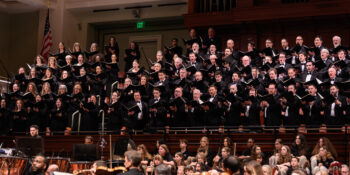
It was with great pleasure that I was able to attend the Nashville Symphony’s concert, Beethoven’s Ninth: Ode to Joy, on Friday February 7th. The orchestra was led by conductor , and the show featured Ellie Dehn, Jennifer Johnson Cano, Alek Shrader, and Davide Leigh as soprano, mezzo soprano, tenor, and bass respectively. The program started with Fate Now Conquers, a contemporary piece composed by Carlos Simon. This was followed by Ravel’s 3-piece song cycle Scheherazade, and the concert concluded with the much-anticipated Symphony No. 9 in D minor, Op. 125 by Beethoven.
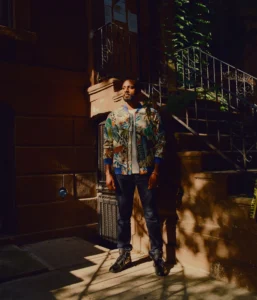
As stated, the night started off with Fate Now Conquers. Carlos Simon composed this work as a response to Beethoven’s Symphony No. 7, so it was a nice thematic fit to a Beethoven concert. The piece itself begins with fast, frantic strings that ebb and flow throughout the rest of the song. Dissonance, shifting dynamics and instrumentation, and varied pacing all help conjure up the idea of fate the composer was intending. While the strings, and to a lesser extent the winds, tend to carry the composition, I found myself most entranced with the trumpet parts. Multiple muted trumpet sections provided a touch of modernity to a piece that otherwise blends in well with classical tradition. When the mutes were removed the trumpets also helped punctuate the more powerful moments of the piece.
Despite being a Beethoven concert, it was really Shéhérazade that stole the show. This was due in large part to the vocal talent of Jennifer Johnson Cano, but this does not mean interpretation by the orchestra should be ignored as that too was exquisite. In the past couple of weeks, the symphony has played a lot of Ravel, with Empress of the Pagodas finding a spot in their lunar new year show, and their concert celebrating Ravel’s 150th birthday. Perhaps at this point, they have just learned how to bring out the best of the French composer’s music. The song cycle was Ravel’s second attempt at portraying the exoticism of The Arabian Nights.
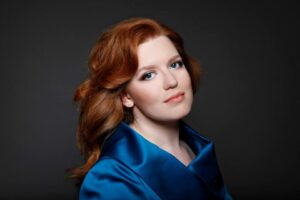
The cycle begins with “Asie,” the piece that most prominently invokes the contemporary western stereotypical “exotic eastern” sound. What the piece lacks in cultural authenticity is certainly made up for in its unique and intoxicating themes. The singer’s opening invocation of “Asie” instantly transports the listener to the mythical realm Ravel pictured. The song gives all of the orchestra chances to shine with glittering string passages, climactic brass sections, and interesting woodwind call and returns. Next in the cycle comes, “La Flûte Enchantée,” which, as one might expect, heavily features the flute. This piece is really just a dance between the singer and the flautist with support from the rest of the orchestra. As for the performance, what more can I say than the flute really was magical in this one. Finally, the cycle ends with “L’indifférent.” This is a wistful and melodious song that details a passing interaction between an androgenous youth and an admiring narrator. In contrast to the previous songs in the cycle, the singer carries more of the melody as opposed to the more chanting style of “Asie” and “La Flûte Enchantée.” Underneath the singer are some subtle yet beautiful string and woodwind passages. As a whole, the cycle is complex and interesting. It fit nicely in the program between “Fate Now Conquers” and Beethoven’s Ninth, really helping to add some contrast to the bold style of the other works.

After intermission came the main attraction, Beethoven’s Ninth. As this is one of, if not the most, recognized pieces of classical music in the world there is little to offer here in terms of exposition. I will say that this symphony was revolutionary at its time for the inclusion of vocal scoring. The climax of Ode to Joy, featuring the full chorus, remains just as impactful today. I’m happy to say that the Nashville Symphony did this work justice. The symphony was energetic and powerful. Again, I was especially impressed with the vocal soloists with Davide Leigh proving to be a real standout. All in all, it was the perfect culmination to the rest of the program. I would be remiss if I didn’t also acknowledge Nicholas Hersh’s commanding stage presence. It was a pleasure watching him seem to explode in stature along with the energy of this work.
The Nashville Symphony has truly delivered at the start of this new year, and I, for one, can’t wait to see what else they come to offer the rest of this season.
From Nashville's most intimate boards
Alice by Heart at the Barbershop
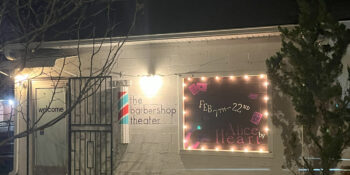
Street Theatre Company’s Alice by Heart, directed by Leslie Marberry, opens this weekend at the Barbershop theater in West Nashville. I was lucky enough to view the final dress rehearsal on Thursday, and I am happy to report, again, that Street Theatre is setting the bar for intimate, low-cost, high passion, theatrical performances in Nashville with this powerful coming of age narrative that engages with the fleeting nature of love, the experience of loss, and the resulting grief and resilience.
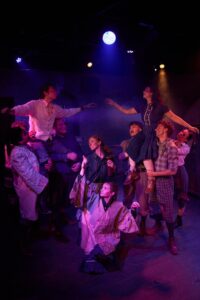
With Music by Duncan Sheik and lyrics by Steven Sater, the musical opens in a World War II bomb shelter under London where we meet Alice Spencer and her best friend Alfred who is dying of tuberculosis. Strikingly, the entire cast is already on the stage—across the evening 29 characters will be played by 10 actors (some by design, others, it seems, by happenstance). At first one might wonder if this doubling would be daunting or confusing, but the parallels it creates are very interesting. For example, the bomb shelter nurse who diagnoses Alfred also plays the Queen of Hearts in Alice’s delusional world (this is the Wonderland they visit). This relates the arbitrary nature of life and death in the bomb shelter to the blind fury of the Queen who gives a death sentence at the slightest offense. It is no wonder that the (pre)teen Alice would see these characters as one in the same. In this, the stern Savannah Stein was fantastic, whether as the pragmatically determined Nurse or the franticly insane regent, her versatility was incredible, and the facial expressions were obnoxiously bold—I can still see the insanity in her eyes as she belted “OFFFFFFFF WITH HER HEADDDD!”
The sweet, caring, and long to anger Alice was played very well, and with wonderful subtleness, by Sachiko Nicholson. Her innocence in appearance and stage presence, well complemented in expression and singing voice, belied an onstage charisma that pointed, appropriately, to someone more sophisticated than Lewis Carroll’s irksome seven-year-old child. This Alice is different, she has experienced war; she is older, smarter and more disciplined—even in Wonderland. She carried the show, and it is a good thing that she did because I don’t believe the script ever permitted her to leave the stage.
The ailing and sensitive Alfred, who is also always in a hurry, was played by a charming Simon Elliott who employed his piercing blue eyes and tall but not imposing body language to create a great chemistry with everyone around him. Grayson Stanko’s catty nature came out well in the production, and the nuance of her smile (the raised upper lip that suggests a healthy dose of aggression in her levity) was just perfect, even as she provided Alice the ambiguous advice that she didn’t need. Speaking of smiles, Ben Friesen’s smile was downright infectious pairing with an excellent sense for physical comedy in the expression of his mercurial hatter’s madness.
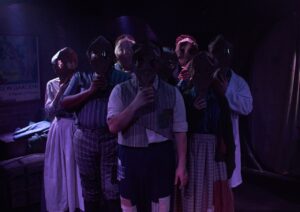
Parker Jenkin’s symbolist poetry, on the other hand, was more of a secco comedy—dry, sparse yet still physical, and his singing voice was outstanding—might there be an Ian Gillan’s “Gethsemane” lingering in there somewhere? Marco Tomás’s Duchess’ was as funny as she was ugly (the Duchess was ugly not Tomás) while Xavier Wilson’s onstage presence was excellent.
One remarkable aspect of this adaptation of Carroll’s story is the Caterpillar. For Carroll this hookah-smoking insect informs Alice on how to grow large and shrink small. Our Alice Spencer seems to be somewhat older, and Xavier May and Shelby Talbert’s Caterpillars are seductively fantastic, pointing not to Alice’s changing height, but instead to her developing the curves of a woman’s body. Their scene is a hilarious burlesque.
This brings us to the choreography, which, like so much else, was just outstanding. Joi Ware’s caterpillar and turtle are imaginative, but her dance numbers, featuring so many characters in such a small space, came off in eloquence and charm. Leslie Marberry’s blocking was similarly efficient in that there was never a moment when I thought I couldn’t see something that I wanted to—the stage was used incredibly well. Bonny Green’s costumes were well thought out, whether it be Alice’s traditional blue dress or the Queen’s crown, and Garner Harsh’s set was functional, yet believable. It was amazing what they achieved in such a small space.
All of this is to say that the overall challenge of the play (and one of the primary factors of the success of this production) is in creating a balance between the dreary world of the bomb shelter and a cheery Wonderland in Alice’s delusion. In this, whether just through the smiles of the characters, Kristin DuBois’ subtle lighting design, Jacob Allen’s fiery sound design, the costumes or scenery, the balance was achieved in a way that gave us both worlds. The best example comes in the first few moments, when Alice finally convinces Alfred to leave the bunker and join her in Wonderland, the dissipation of anxiety was palpable and yet difficult to connect to any one aspect of the production. Everything worked together, so I expect the primary complement should be given to Director Marberry.
One drawback of the evening, which is probably a weakness in Sater and Jessie Nelson’s book, has to do with pacing. At some moments, particularly in Wonderland, the vocal numbers seemed forced—the shift from dramatic action to soliloquy was less fluent than it could be, and the action felt interrupted by the number, not enriched. This was, however, a very small thing in an otherwise outstanding production.
A final point. In Nashville, we have a giant list of world class artists competing for your dollars performing in the most beautiful venues—including the glitz of Nashvegas, Broadway shows at TPAC (or the new multimillion dollar complex that will replace it across the river) or the fancy, long heralded, New York Theatre companies appearing at the cigar tycoon’s art project, or even Belmont’s Fisher Center, “another crown jewel” for Music City. The Street Theater Company, a resident of the Barbershop Theater (itself a cinder block box in a construction zone), is an underdog, but with the grit and determination of a Tennessee Tick Hound. They have fire in their eyes, hunger in their bellies and art in their hearts. Take my advice: do something meaningful in Nashville and go see Alice by Heart next weekend (this weekend is already sold out).
https://www.streettheatrecompany.org/
The Cosmopolitan Baroque on Broadway
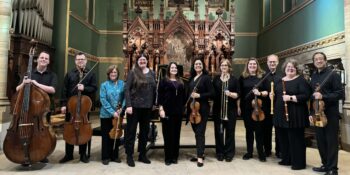
It was Sunday, February 2nd, to be exact, and Music City was alive with the sounds of traffic and people chatting away, making their way across streets in a rush before the pedestrian signs would change their colors, chirping like artificial birds. Christ Church Cathedral, which sits at the heart of this cacophony on Broadway, offered respite to the audience members who gathered to listen to Music City Baroque, who would transport them not only back in time but to a different continent.
I had snuck into the cathedral just in time to hear the ensemble tuning, that glorious monster of sound ricocheting off the stone walls and high ceilings, as I took a seat near the front not wanting to miss a second of the musical tour around 17-18th century Europe. As Music City Baroque, led by Artistic Director Maria Romero Ramos, began their first piece, the difference between modern instruments and those used during the Baroque became more apparent. The stringed instruments used gut strings rather than steel or synthetic materials, and the bows were shorter. The harpsichord was painted a glorious emerald green with gold accents and its strings, instead of being hit by small hammers like the piano, were plucked, giving it a brighter quality.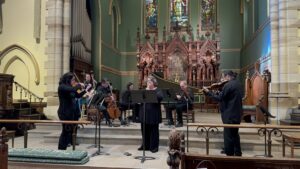
The first composer on our journey was Georg Philipp Telemann (1681-1767). As one of the most prolific composers of his day, his style included elements from all the countries he had visited. His piece Overture Suite in A minor included French, Italian, and Polish styles, though Teleman himself was German. The first movement, the ouverture, is a traditional French piece that historically heralded the king’s arrival. The dotted eighth and sixteen notes that run rampant throughout the florid ornamentation of this first movement, and the two contrasting sections, are some of the distinguishing features of French overtures. The final section, a Polish Polonaise, was in a dance-like 3/4 meter with playful, lilting rhythms taken up by the recorder, which ended the piece. Jessica Dunnavant did a shockingly prodigious job as the recorder soloist. The breath support needed to get through the long melismas accurately, almost without any break throughout the suite, is a feat that Dunnavant accomplished with what seemed to be little effort.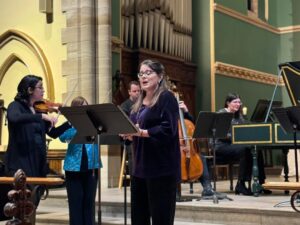
Next, we visited George Fridrich Handel (1685-1759). Although German by birth, he found success overseas in England where he spent most of his life. However, The Nine German Arias call back to Handel’s youth. Soprano Mary Wilson was taken ill and unable to perform, but luckily, Terri Richter, one of Christ Church Cathedrals’ sopranos, stepped in and saved the day. With only three days’ notice, she did an impressive job preparing two of Handel’s Nine German Arias. Meine Seele Horte is a fast-paced upbeat piece with melismas, fun trills, and text painting galore. The trills traded back and forth between the soprano and violin imitating the birds of spring and was a delight to listen to.
I must describe our third stop by starting at its end. Pride and delight shone on the faces of our musical guides as they took their bows after a wonderfully played piece. It was heartening to see that they truly enjoyed performing it. Sonata in G minor is remarkable for several reasons. The first reason is the piece’s composer, Elisabeth Claude Jacquet de la Guerre (1665-1729). Born into a musical family, her father a harpsichord builder and organist, was her first teacher. Her father must have been a successful teacher because Guerre was a child prodigy. She performed for King Louis XIV and made such an impression that she was granted a place in court under the tutelage of Madame de Montespan. She was one of King Louis XIV’s court musicians and was able to publish most of her music. In the Sonata in G minor, the contrasting moods of the movements and the continuously trading melody between instruments not to mention the virtuosic cello solo at its end made the piece well worth listening to; featuring not only French but Italian style rhythms.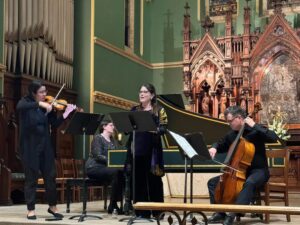
Johann Sebastian Bach (1685-1750) one of the Baroque era’s most famous composers was the last stop on our journey. Cantata BWV 51, Jauchzet Gott in Allen Landen translates to “praise God in all the land” and includes some of the most foreign elements Bach used in his works. With instrumentation consisting of soprano, natural trumpet, and strings, it is reminiscent of Italian cantatas in its structure. The cantata is separated into five movements: An aria, recitativo, aria, choral, and aria. Throughout the cantata, Bach never ceases to impress with his masterful text painting. The first lines “Jauchzet Gott in Allen Landen” ascend to the heavens with a virtuosic soprano line whose melody is continued by the trumpet. The natural trumpet was a much larger instrument than the modern version and did not have valves, but rather finger holes, similar to that of a recorder, and plays notes along the harmonic series. The sound is mellow, with a lightness that is hard to find in the modern equivalent. I cannot say enough about both soloists, but the artistry and dynamic control that Kathryn Adduci displayed were impeccable. Even as she began the piece, accompanied by strings, heralding in a tune reminiscent of a royal fanfare, I was taken by the subtle attention to detail she played with. This piece is virtuosic and highlights both soloists. I cannot say enough for Kathryn Adduci and Terri Richter.
As the concert ended and we all returned from our trip through 17-18th century Europe, I was struck by the passion every musician on stage had played with. The emotion and openness with which they played, and the educational opportunity they continue to provide as the only period ensemble in Nashville ensured that I will be looking forward to their next concert with anticipation.
The Mountaintop

Celebrate Black History Month by seeing Katori Hall’s The Mountaintop. The Tennessee playwright is the first Black valedictorian who graduated from Craigmont High School in Memphis before earning degrees from Columbia University, Harvard University, and Julliard.
In her breakthrough play, Katori re-imagines Dr. Martin Luther King Jr.’s last night before his assassination. The play begins with a beautiful, mysterious maid visiting King’s room at the Lorraine Hotel. Their conversation starts as light-hearted and flirtatious but eventually progresses into a deeper discussion King’s hopes and fears regarding the fight for civil rights.
 explores the Civil Rights Movement through the characters’ connection and understanding as African Americans in the 1968s. Full of symbols that give hidden meanings, the play will surely raise thought-provoking questions worth discussing.
explores the Civil Rights Movement through the characters’ connection and understanding as African Americans in the 1968s. Full of symbols that give hidden meanings, the play will surely raise thought-provoking questions worth discussing.
The Mountaintop will run from February 14th to February 23rd at TPAC’s Johnson Theater. For more information, visit the Nashville Repertory Theatre.
& Juliet

Most of us know of Shakespeare’s Romeo and Juliet by heart. The classic tragedy follows the termitous love story between two teenagers whose passionate love leads to their demise. But what if Juliet didn’t end it all for Romeo?
Created by the Emmy-winning writer from Schitt’s Creek, & Juliet explores that exact question. Instead of taking her own life for love, Juliet is whisked away on a new beginning, setting out for a journey that gives her a second chance at life and love.
& Juliet features a playlist of pop anthems. With hits from Britney Spears, Katy Pary, Ariana Grande, and more, the romantic comedy will surely be a hit with the entire family. The event will be performed at TPAC’s Jackson Hall from February 11th to February 15th. Tickets are on sale now at TPAC.org.
Farm to Table to Body at the Frist
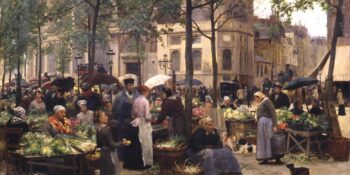
Jean Anthelme Brillat-Savarin said, “tell me what you eat, and I will tell you who you are.” Food is intrinsically tied to our identities. The time period we are in, the place we
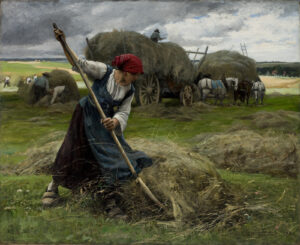
live, our socioeconomic class, much more than just personal taste, affect what we eat. The Frist Art Museum’s new exhibitions, Farm to Table: Art, Food, and Identity in the Age of Impressionism and Tennessee Harvest: 1870s-1920s explore these themes. The focus of these exhibitions is food in all its stages: production, preparation, and consumption.
In the first exhibit, the audience is invited into a look at France’s food through almost 60 works from the late 19th century divided into five sections: farming and husbandry, marketplace, food workers, still life, and places where French men and women consumed meals. In the first section, farming and husbandry, we see images of the labor it takes to produce food. The piece that first caught my eye was Haying Scene by Julien Dupré which depicts a woman turning hay. She is clearly doing hard labor, but she is bright and beautiful. Her work is necessary and appreciated. The exhibit also includes La Meule (The Haystack) by Claude Monet, one of the 25 haystacks that he painted showing heaps of harvested grain.
Markets and shops are the focus of the second section. On a wall by itself is the piece that inspired the curator, Andrew Eschelbacher, to assemble the exhibit: A Rat Seller During the Siege of Paris in 1870 by Narcisse Chaillou. During the Franco-Prussian War, the French had so little to eat that they resorted to butchering and eating rats. Rather than something to be ashamed of, this becomes a point of national pride. The painting is not bleak and depressing. The colors of the French flag adorn the walls and the butcher is almost smiling as he rolls up his sleeves, rosy cheeked. It’s as if he is saying, “Yes, we’re eating rat, and what of it? It will taste better than the steak filet cooked by any other country.”
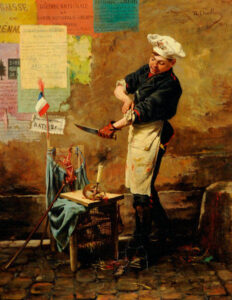
Other paintings, such as Fish Market at Les Halles by Victor Gabriel Gilbert, show the differences between social classes: a wealthy woman and her servant as well as the sellers, and how the market brings them together. The third section of the exhibit features food workers: cooks, butchers and servers. The viewer is reminded that this is another step in food preparation that must be appreciated. While slabs of meat, such as in Meat Haulers by Victor Gabriel Gilbert are not beautiful to look at, there is a beauty in the work to be done. The museum label provides interesting context as well: “The neighborhood surrounding Les Halles had been the site of violent uprisings in Paris, and authors frequently used descriptions of animal carcasses as metaphors for revolutionary corpses.” The fourth section is comprised of still lifes of meat, fish, fruits and vegetables. Prior to this exhibit, I had given very little thought to still lifes other than how boring I found them. What a delight to learn that these paintings contain hidden messages and symbols. Gustav Courbet’s painting of apples for example, is a political message, symbolizing his support of the working people. The Dessert (The Remains of the Meal) by Étienne-Prosper Berne-Bellecour depicts a decadent scene of a leftover feast with sugar cubes and sweet delicacies to remind the viewer of France’s dependence on colonial sugar production. Still Life with Pomegranates by Henri Regnault shows shriveled, old pomegranates on a blanket. The museum label tells the viewer that decayed fruit in still lifes serves as a memento mori, a reminder that we will all die and decay.
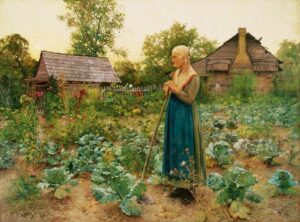
The last section is places that French people ate their meals. The section beautifully highlights the different social classes in France at the time. Some are comfortable salons filled with people as in La Brasserie by Jean Béraud. Others are more intimate scenes like the couple enjoying a simple meal in Under the Lamp by Marie Bracquemond. And still others show harder lives, like that of the young domestic worker in Girl Eating Porridge by William-Adolphe Bouguereau and the young, impoverished girls in The Orphans by Léon-Jean-Bazile Perrault.
The end of the fifth section leads the viewer directly to the next exhibit, Tennessee Harvest: 1870s-1920s. This exhibit shows connections between paintings made in Tennessee or by Tennesseans to the French art in the previous exhibit. Not only are the paintings similar, but some of the Tennessee painters were actually taught in France by painters in the first exhibit. In the Tennessee Mountains by George W. Chambers shows an old woman standing in her patch of cabbages, weary but determined. It has some similarities to Haying Scene by Julien Dupré who was his teacher.
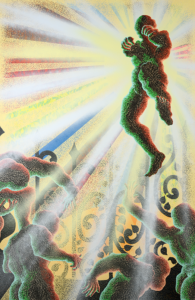
The Frugal Repast by Willie Betty Newman was painted in France by a native Tennessean. She studied under William-Adolphe Bouguereau and similar to his Girl Eating Porridge, her painting also shows a peasant girl eating, but her girl has paused to look right back at the viewer. As the exhibit goes on, we are invited to recognize what the paintings omit: black farmers and enslaved people that made this agricultural society possible. I was expecting to enjoy the Farm to Table exhibit, and I did very much, but I didn’t realize how much I would love the Tennessee Harvest exhibit. I didn’t know any of these artists previously and I was surprised how much pride I felt seeing such beautiful paintings done by Tennessee artists. Despite having no family from Tennessee, I felt as if it could be my ancestors peeling apples in Women at Work by Lloyd Branson.
While you’re there, go to the always innovative Gordon Contemporary Artists Project Gallery (CAP Gallery) to see M. Florine Démosthène and Didier William: What the Body Carries. This is an exhibition of works by two Haitian American artists that explores diversity and the immigrant experience. I was fortunate enough to hear both artists speak and they addressed the ignorant and hurtful claims made publicly by several administration officials. Démosthène and William reminded us that this kind of bigoted and hateful speech is nothing new. Redemption, Resurrection by William is particularly powerful piece that shows his oldest brother as a superhero, defending his other brother from bullies. Both artists use eyes in their work, having the subjects look back at the viewer rather than just passively allow themselves to be observed.
All of these amazing works will be up through May 4, 2025. There’s a delightful cafe in the Frist downstairs. Make a whole afternoon of it; you wont regret it!

